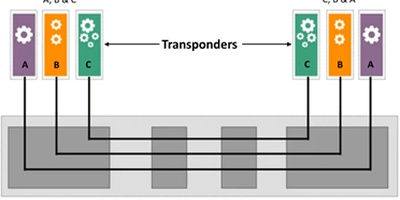The Future of Networking: Revolutionary Developments in Bandwidth, Power Efficiency, and Sustainability

The networking landscape has experienced remarkable growth and transformation in recent years, driven by factors such as the proliferation of cloud use cases, increasing data consumption by consumers, and the ubiquity of mobile devices. One of the key challenges facing the industry is striking a balance between the rising demand for bandwidth and data and maintaining sustainability and power efficiency. This blog explores some of the latest innovations in networking technology, with a focus on Cisco's 800 Gig line card and how it aims to address these challenges.
Demand for High-Capacity Solutions
The surge in demand for bandwidth and data has led to the emergence of two primary customer segments as the main focus for networking solutions: telecommunications companies (telcos) and hyperscalers. Hyperscalers are responsible for constructing vast artificial intelligence and machine learning clusters that necessitate massive amounts of data and traffic. In contrast, telcos are charged with economically and sustainably transporting this increasing traffic across their networks.
Journey to 800G
The move to 800G is marked by significant milestones in networking technology, with each generation bringing about increased speeds and improved performance:
- 10G: The first generation of high-speed networking, offering 10 times the bandwidth of 1G.
- 40G: The next step in the evolution, providing 4 times the capacity of 10G.
- 100G: This generation saw a 2.5x increase in bandwidth over 40G, further enhancing data transmission capabilities.
- 400G: The current industry standard, offering a fourfold increase in speed compared to 100G.
As data demands continue to grow exponentially, the networking industry has been striving to develop even faster solutions. The upcoming 800G technology is set to deliver unprecedented speeds, doubling the capacity of 400G.
Benefits of 800G
The introduction of 800G offers several key advantages:
- Enhanced performance: With 800G, data centers and networks will be able to support higher bandwidth requirements for applications such as AI, machine learning, and big-data analytics, resulting in improved overall performance.
- Increased efficiency: The adoption of 800G will enable organizations to reduce the number of switches and routers required in their networks, leading to lower power consumption and reduced operational costs.
- Improved scalability: As businesses continue to grow, 800G will provide the necessary infrastructure to support the increased demands on networks, ensuring seamless scalability and reliability.
Cisco's Timely 800 Gig Line Card Introduction
Cisco's 800 Gig line card is a significant milestone in the networking industry, offering unparalleled capacity and performance levels. Built on Cisco's P-100 silicon, the line card is capable of supporting an impressive 28.8 terabits of data, making it the first of its kind to reach the market. The line card has been meticulously designed to fit seamlessly into Cisco's existing product portfolio, providing customers with a hassle-free upgrade path from 400 Gig to 800 Gig connections.
The following are the key features of the 800 Gig line card
- High-density and capacity: The 800 Gig line card boasts an impressive 36 ports of 800 Gig each, empowering customers to double the capacity of their systems while maintaining the same physical footprint.
- Backward compatibility: The line card offers compatibility with existing 400 Gig and 100 Gig optics, allowing customers to upgrade their systems without necessitating extensive infrastructure overhauls.
- Power efficiency and sustainability: As sustainability becomes more important in the networking landscape, the 800 Gig line card has been optimized for power consumption. Both non Media Access Control Security (MACsec) and MACsec capable versions are available to cater to a diverse range of customers’ requirements.
- Flexibility: The versatility of the line card enables it to be employed across various use cases: data center interconnects, IP backbones, and high-performance computing clusters.
- Seamless integration: The 800 Gig line card fits effortlessly into all of Cisco's existing product lines, providing a unified and comprehensive solution for customers.
Implications of the 800 Gig Line Card for the Networking Industry
The debut of the 800 Gig line card signifies a substantial leap forward in networking technology, adeptly addressing the mounting demand for high-capacity, power-efficient, and environmentally friendly solutions as well as play a vital role in shaping the future of networking.
The role of hyperscalers and telcos in the new networking landscape cannot be overstated. As these entities continue to expand their operations and push the boundaries of technology, the demand for cutting-edge networking solutions will only grow. The 800 Gig line card is an example of the type of innovation required to meet these demands, demonstrating that the future of networking is not only faster and more powerful, but also more sustainable and efficient.
As more companies adopt advanced networking solutions like the 800 Gig line card, the overall impact on the environment will be substantial. Reduced power consumption and increased efficiency will lead to a significant reduction in the carbon footprint of data centers and network infrastructure. This is especially important as concerns about climate change and the need for sustainable practices continue to grow globally.
Moreover, the backward compatibility and seamless integration features of the 800 Gig line card ensure that customers can upgrade their systems without the need for extensive infrastructure changes. This not only reduces the cost of deployment, but also minimizes the potential for service disruptions and downtime during the upgrade process. As a result, companies can more easily adapt to the evolving demands of the networking landscape while maintaining a focus on sustainability and efficiency.
The flexibility of the 800 Gig line card further solidifies its position as a groundbreaking innovation in the networking industry. The ability to be used across various use cases, including data center interconnects, IP backbones, and high-performance computing clusters, means that customers can take full advantage of the increased capacity and performance without being locked into specific applications or environments. This level of flexibility is crucial as companies continue to expand their operations and explore new technologies, such as artificial intelligence, machine learning, and edge computing.
As networking technology continues to advance, it is critical for industry leaders like Cisco to maintain a focus on sustainability and power efficiency. The introduction of the 800 Gig line card is a testament to the company's commitment to these principles and demonstrates that it is possible to develop cutting-edge solutions that prioritize both performance and environmental responsibility.
Road Beyond 800G
While 800G is certainly a significant milestone in networking technology, the industry is already looking ahead to what comes next. As data demands continue to grow, researchers and engineers are exploring new ways to push the boundaries of data transmission:
- Terabit Ethernet: The development of Terabit Ethernet, which will offer speeds of up to 1 Terabit per second, is already underway. This technology is expected to provide a tenfold increase in capacity compared to 100G, revolutionizing networking capabilities and driving further innovation.
- Optical innovations: Advancements in optical technologies, such as silicon photonics, are paving the way for even faster and more efficient data transmission, further expanding the potential of networking technology.
Looking to the Future
The 800 Gig line card represents just the beginning of the next era in networking technology. As the industry continues to push the boundaries of what is possible, we can expect to see further innovations in areas such as optical networking, automation, and edge computing. These advancements will not only serve to enhance the performance and capacity of networks, but also continue the push toward more sustainable and power-efficient solutions.
In the coming years, we can expect to see an increased focus on the development of new technologies and standards that support even higher capacity connections. The race to terabit-scale networking is already underway, and as the demands of hyperscalers, telcos, and other high-bandwidth consumers continue to grow, the need for increasing capacity will only become more pronounced.
The industry is likely to see a continued emphasis on the development of more efficient and sustainable networking solutions. Innovations such as the 800 Gig line card will serve as the foundation for these future advancements.
Cisco's 800 Gig line card represents a significant step forward in the evolution of networking technology. By addressing the growing demand for high-capacity, power-efficient, and sustainable solutions, this groundbreaking innovation sets the stage for a new era in the networking industry. As the landscape continues to change, innovations like the 800 Gig line card will play a crucial role in shaping the future of networking, ensuring that service providers and hyperscalers can effectively meet the evolving needs of their customers.
For more information on service provider market, please contact Ray Mota at rmota@acgcc.com.



















































